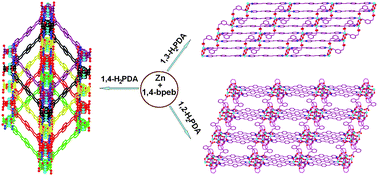Ligand geometry-driven formation of different coordination polymers from Zn(NO3)2, 1,4-bpeb and phenylenediacetic acids†
Abstract
The hydrothermal reactions of Zn(NO3)2·6H2O with

* Corresponding authors
a
College of Chemistry, Chemical Engineering and Materials Science, Suzhou University, Suzhou, P. R. China
E-mail:
jplang@suda.edu.cn
Fax: +86-512-65880089
b State Key Laboratory of Coordination Chemistry, Nanjing University, Nanjing, P. R. China
The hydrothermal reactions of Zn(NO3)2·6H2O with

 Please wait while we load your content...
Something went wrong. Try again?
Please wait while we load your content...
Something went wrong. Try again?
D. Liu, Y. Chang and J. Lang, CrystEngComm, 2011, 13, 1851 DOI: 10.1039/C0CE00575D
To request permission to reproduce material from this article, please go to the Copyright Clearance Center request page.
If you are an author contributing to an RSC publication, you do not need to request permission provided correct acknowledgement is given.
If you are the author of this article, you do not need to request permission to reproduce figures and diagrams provided correct acknowledgement is given. If you want to reproduce the whole article in a third-party publication (excluding your thesis/dissertation for which permission is not required) please go to the Copyright Clearance Center request page.
Read more about how to correctly acknowledge RSC content.
 Fetching data from CrossRef.
Fetching data from CrossRef.
This may take some time to load.
Loading related content
